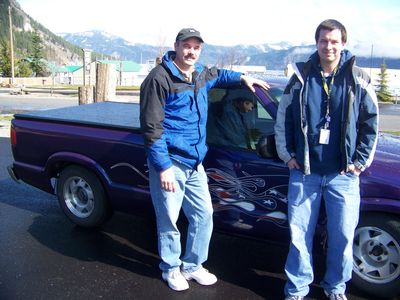Engineers build electric commuter

Everyone has a hobby or something that they do to entertain themselves or others after work or on weekends. Some hang out at a local pub, others go fishing or golfing.
Engineers, however, are a different breed altogether.
Engineers, when finished building stuff, go home and do more of the same. Such is the case involving two engineers working at the Acoustical Research Detachment of the U.S. Naval Surface Warfare Research Division in Bayview.
This research facility is all that is left of the massive Farragut Navy base, used for basic training during World War II. The balance of the former base is now Farragut State Park.
Citing high gas prices, Duane Nightingale, 47, and his commuting buddy Dave Mellick, 29, set out to do something about it.
The two friends had been car pooling from Rathdrum to Bayview for several years. They decided to build an electric plug-in car that could travel the 27 or so miles between the two cities. They would leave it on charge while at work, then make the return trip home. Dave is a computer engineer and Duane is an acoustical engineer. Duane has been at the Bayview facility for 12 years and Dave for six.
They chose to start with a 1995 GMC Sonoma they found on Craigslist. The price was $1,400. The pair drove to Spokane, purchased the light truck and headed back. They got about halfway home when the engine blew up. Outside of the $200 tow bill, that was all right, said Duane. They hadn’t planned on using the engine anyway.
The total cost of the conversion was around $11,000, a figure I had to promise not to reveal to their wives. My lips are sealed, guys.
They started with a “Netgain” Warp 9 Series Wound DC motor, mated to the original GMC transmission with a Canadian EV adapter plate, connecting the two. The transmission is the original GMC 5-speed manual. The controller is a Mellick Warp Drive 1000 DC Converter engineered for superior performance in this application.
All engineering was performed by Dave, with the mechanical work accomplished by Duane. The batteries, all 12 of them, are 12-volt deep cycle marine-type batteries connected in series, giving them 144 DC volts total. The builders used the bed of the truck for the batteries and other paraphernalia, such as an emergency portable generator and junction boxes. The recharge system is set up for 110 volts, AC for convenient plug ins.
After extensive testing, it was determined that the truck was comfortable with highway speeds of about 65 mph and the range, 40 miles. Instrumentation includes speedometer, RPM, amps and volts. The total weight is estimated at 3,600 pounds. Some additional work was done on the suspension, needing the removal of two coils in the front springs and the addition of heavy duty air shocks, so that the weight of the batteries wouldn’t drag down the tail.
The two friends are cruising from Rathdrum to Bayview in dead silence and zero fuel cost. They estimate that the truck takes under $1 a day to recharge.
Who says automotive engineering has to take place in Detroit or Japan?